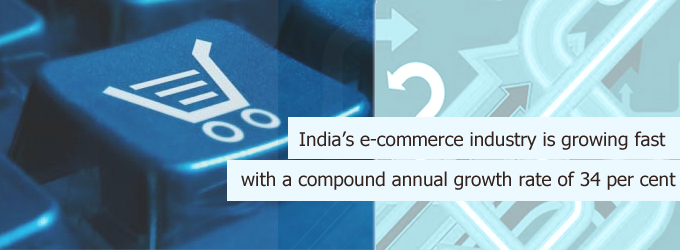|
The e-commerce industry in India is increasingly emerging as a preferred sales channel for businesses with an expanding internet user base. Making good of the opportunity, online retailers like Flipkart, Amazon and Snapdeal are racing to capture a major chunk of the market and are leaving no stone unturned in achieving their goals.

Flipkart, founded in 2007, is one of India's biggest online retailers. The firm has 22 million registered users, over 3,000 sellers, and handles over 1,50,000 shipments a day. In May this year, Flipkart bought rival Myntra, which was India’s biggest e-commerce merger till date. The firm recently raised $ one billion in funding, mostly from investors led by Tiger Global, Naspers and Accel Partners.
Flipkart also inked a unique tie-up with OLX, an online marketplace for used goods, recently. As per the joint marketing deal, consumers can upgrade by selling used products on OLX before buying the new products on Flipkart.
Snapdeal, the Delhi-based online marketplace, was started in February 2010. The e-tailer presently works with over 50,000 sellers and has 40 fulfilment centres in 15 cities. It is planning to open fulfilment centres in 15 more cities over the next one year to attract one lakh sellers. Fulfilment centres are giant warehouses that help online retailers store many products, ship them and handle returns quickly. It is likely to hit the one lakh sellers’ mark before the end of FY15. Snapdeal has already raised two rounds of funds so far this year, taking the total capital raised to about $350 million.
The online market in India became more interesting with the entry of Amazon. Its Indian arm has already started giving stiff competition to Flipkart and Snapdeal. The e-tailer opened its Indian website in June 2013 and has expanded its seller base from a mere 100 to 9,000. And just a day after Flipkart attracted $ one billion of fresh funds in July 2014, Amazon also announced its plans to invest $ two billion in India.
In order to provide next-day and same-day guaranteed delivery services to its users, Amazon plans on opening five new fulfilment centres in India. These new centres will be opened in Delhi, Chennai, Jaipur, Ahmedabad and Tauru in the outskirts of Gurgaon. The expansion will increase Amazon’s fulfilment space by half a million square feet and provide retailers from both, South and North India, closer access to the company's fulfilment capabilities. The online retailer opened its first fulfilment centre at Mumbai in 2012, followed by one in Bangalore. Amazon is also planning to build a centre in Hyderabad which will be its biggest facility outside of its corporate headquarters in Seattle.
Investing in logistics and warehousing is going to be a recurring phenomenon amongst the e-commerce players in India as they try to expand their market base. A joint report by the ASSOCHAM and PwC estimates that over the next three to four years, warehousing capacity of e-commerce companies could increase by upto 12 per cent and that there will be an addition of 7.5-15 million square feet of space in the form of fulfilment centres. The e-commerce industry as a whole is expected to spend $ 950-1,900 million on infrastructure, logistics and warehousing between 2017 and 2020.
Despite the hype, the Indian e-commerce industry is at a nascent stage with 25 million online buyers. Online retail was just 0.5 per cent of India's total retail market of $ 415 billion last year. However, the industry is growing fast with a compound annual growth rate of 34 percent and the potential of reaching a mostly untapped market of 1.2 billion people in the coming years.
The number of online buyers is expected to increase from the current 25 million to over 100 million by 2020. And, with the likely liberalisation of FDI in online retail, which could be a vital factor in attracting significant investments, the e-retail industry is poised to be $ 20 billion by 2020.
|